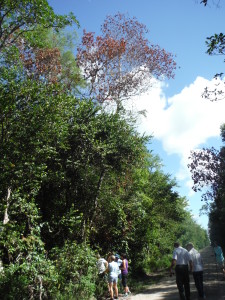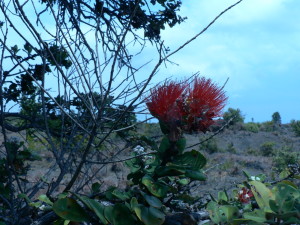Worsening Threats to Hawaii’s Rich – and Rare — Native Forests
As I have written in previous blogs (October 2015; October 2016), the beautiful ‘ōhi‘a lehua (Metrosideros polymorpha) tree is ecologically and culturally the most important tree n the Hawaiian Islands. ‘Ōhi‘a trees dominate approximately 80% of Hawai`i’s remaining native forest. Loss of the species could result in significant changes to the structure, composition, and, potentially, the function, of forests on a landscape level. ‘Ōhi‘a forests are home to the Islands’ one native terrestrial mammal (Hawaiian hoary bat) as well as about 100 plant species listed as endangered by the U.S. Fish and Wildlife Service. Also 30 species of forest birds – in particular, the unique endemic honeycreeper subfamily — depend on ‘ōhi‘a. Eighteen of 19 extant Hawaiian honeycreepers in the main Hawaiian islands, including 12 of 13 bird species listed as endangered by the U.S. Fish and Wildlife Service, depend on ‘ōhi‘a for critical habitat.
Unfortunately, the threat to ‘ōhi‘a trees from three fungi appears to be rising.
“Rapid ‘ōhi‘a death” is caused by two fungi, Ceratocystis lukuohia and C. huliohia (formerly considered to be strains of Ceratocystis fimbriata). Rapid ‘ōhi‘a death has spread since 2010 to most districts of one island: Hawai`i or the “Big” Island. The total area affected is 135,000 acres. Still, most ʻōhiʻa forest on Hawai`i is still healthy, and the disease has not yet been found on any of the other islands. Scientists have begun exploring trees’ varying susceptibility and the possibility of breeding more resistant trees to be used for restoration. For more information, read the recently updated description here.
Ōhi‘a trees are also under attack by a third introduced fungus, called ‘ōhi‘a rust, guava rust, or myrtle rust. This is caused by Austropuccinia psidii (formerly named Puccinia psidii). Ōhi‘a rust has been established on all the Hawaiian islands since 2005. Until recently, it had caused little damage to ‘ōhi‘a – although it attacks several additional native plant species and has devastated the endangered endemic plant Eugenia koolauensis. This shrub can reproduce now only in nurseries where it can be treated for the fungus. In late 2017, an outbreak of the disease caused widespread defoliation and mortality of ‘ōhi‘a across hundreds of acres in at least four locations on windward portions of two islands, O‘ahu and Moloka‘i. It is not yet known whether this new damage resulted from introduction of a new, more virulent strain or from a period of unusually wet weather creating more favorable conditions for the fungus. For more information, read the recently updated description here. (Myrtle rust threatens plants in the Myrtaceae family across the Pacific; more than 450 species have been identified as hosts. Some species in Australia have been severely affected.)
 laurel-wilt killed swamp bay in the Everglades
laurel-wilt killed swamp bay in the Everglades
Severe Attacks on Redbay and other Laurels in the Southeast.
Since the turn of the century, redbay trees (Persea borbonia) in coastal regions of the Southeast have been dying because of laurel wilt disease. This is caused by the fungus Raffaelea lauricola, which in turn is vectored by the redbay ambrosia beetle (Xyleborus glabratus). Both the beetle and disease have spread rapidly since there were detected in 2002 near Savannah, Georgia. The disease now is found in eight states, reaching from eastern North Carolina south along most of the Florida peninsula; across the Gulf states with several locations in Alabama and Mississippi; and to isolated outbreaks in Louisiana and Texas. Already an estimated 320 million trees – nearly one-third of all redbays – have been killed. Mortality is highest where the disease first became established: Georgia (two-thirds of redbays killed), South Carolina (42% of redbays killed), and Florida (36% of redbays killed). In contrast, redbay mortality appears to be quite low in Alabama and Mississippi although mortality caused by disease might have been masked by application of fire or other silvicultural practices.
Other forest trees and shrubs in the Lauraceae family are also at risk. These include swamp bay (Persea palustris), which contribute greatly to the biological diversity of the “tree islands” scattered through the Everglades; sassafras (Sassafras albidum), which occupies a large range reaching into Michigan and southern New England; and two rare species – pondspice (Litsea aestivalis) and the federally listed pondberry (Lindera melissifolia). Northern spicebush (Lindera benzoin), another shrub in the Lauraceae family, does not attract the beetle so it is unlikely to sustain disease. In the West, California bay laurel has been determined by laboratory studies to be vulnerable.
Redbay is important to wildlife and has some use in horticulture. However, most attention has focused on the threat to avocados (Persea americana); the disease was detected in commercial orchards in 2012.
Concerned about loss of this ecologically important tree, scientists have begun efforts to breed redbays that are resistant to, or tolerant of, the disease. In addition to efforts by university scientists, the newly formed consortium Forest.Health (https://forest.health/) has listed redbay as a high priority for resistance breeding. For more information, read the updated description here.

Hope in southern California – possible ecological limits to shot hole borer / fungal disease
John Boland, an ecologist who has studied southern California riparian wetlands for decades, reports that willows in the Tijuana River are recovering from attack by the Kuroshio shot hole borer and the fungi it vectors. After two years, the beetle-vectored disease had infested 88% of the willows in the valley (a total of 355,510 trees). An estimated 24% of the willows had been killed (95,791 trees). Nearly all of the infested and killed trees grew in the wettest parts of the riparian forests. (Photo above illustrates damage at this stage of the invasion.)
However, 71,280 of the willow trees have resprouted. By late 2017, these resprouts had created a new forest canopy that was about 5 meters tall. (Previously, the canopy had been about 20 meters tall). The median rate of infestation of these resprouting willows was 6% in 2017, down from 97% in 2015-2016. Some insect boring holes have healed.
In contrast, willows growing in drier parts of the valley were rarely attacked initially, but are now increasingly infested. In 2017, the median infestation rate was 78%, up from 9% in 2015-16. However, few trees have been killed.
Dr. Boland believes that the severity of the initial attack reflected the vulnerability of “soft trees”. Trees growing in the wetter parts of the Tijuana River Valley are inundated by sewage from the Mexican city. As a result of this artificial fertilization, they grow quickly and their wood is less dense.
For more information about the Kuroshio and phytophagous shot hole borers and their associated fungi, read the description here.. Dr. Boland’s study has been made available to participants in the southern California emerging forest pest groups but I cannot find a publicly available source on the Web.
We welcome comments that supplement or correct factual information, suggest new approaches, or promote thoughtful consideration. We post comments that disagree with us — but not those we judge to be not civil or inflammatory.
Posted by Faith Campbell
